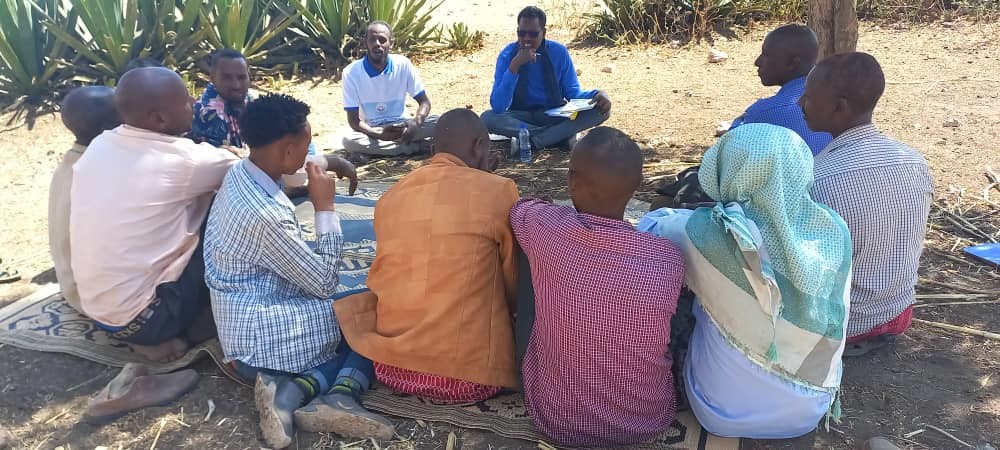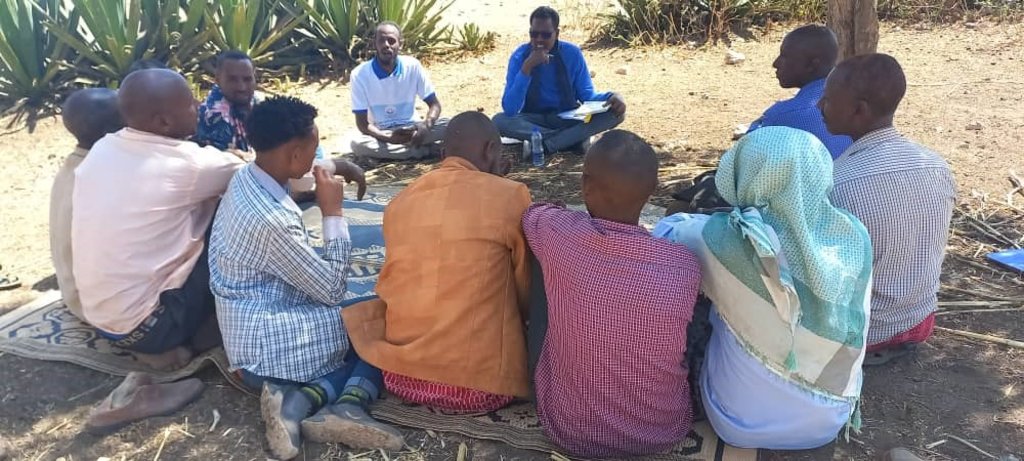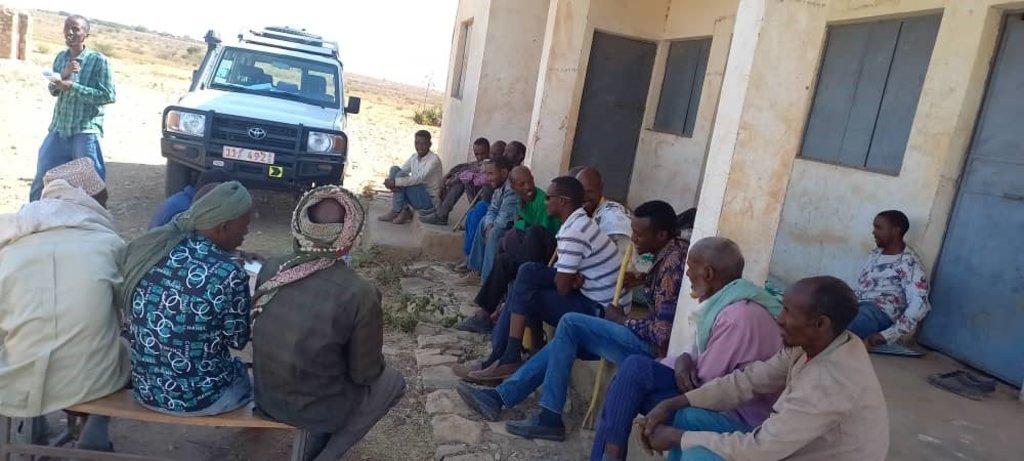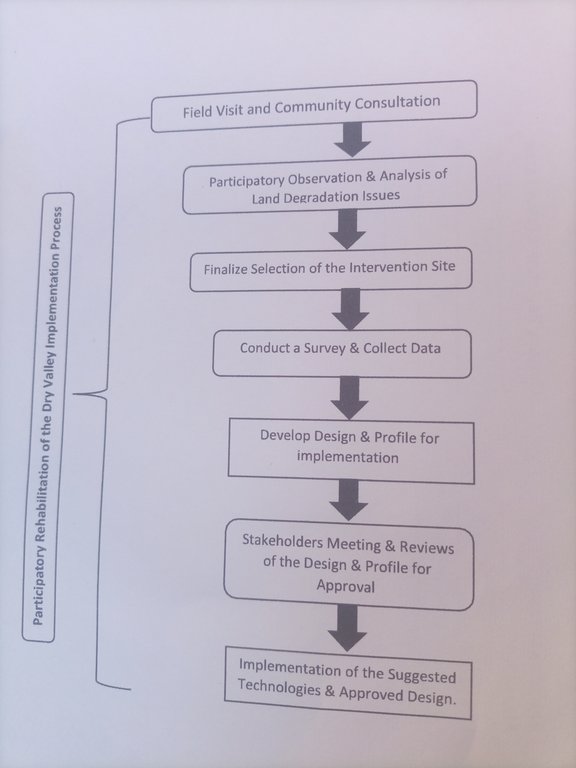Participatory Rehabilitation of Dry Valleys [ប្រទេសអេត្យូពី]
- ការបង្កើត៖
- បច្ចុប្បន្នភាព
- អ្នកចងក្រង៖ GERBA LETA
- អ្នកកែសម្រួល៖ Torben Helbig, Noel Templer
- អ្នកត្រួតពិនិត្យច្រើនទៀត៖ William Critchley, Rima Mekdaschi Studer
Kaqayb Galka Dadwayne
approaches_6718 - ប្រទេសអេត្យូពី
ពិនិត្យមើលគ្រប់ផ្នែក
ពង្រីកមើលទាំងអស់ បង្រួមទាំងអស់1. ព័ត៌មានទូទៅ
1.2 ព័ត៌មានលម្អិតពីបុគ្គលសំខាន់ៗ និងស្ថាប័នដែលចូលរួមក្នុងការវាយតម្លៃ និងចងក្រងឯកសារនៃវិធីសាស្ត្រផ្សព្វផ្សាយ
បុគ្គលសំខាន់ម្នាក់ (ច្រើននាក់)
អ្នកជំនាញឯកទេស SLM:
Omer Ahmed
+251910061493
ahmdomr1954@gmail.com
Natural Resource Department of Somali Regional State Bureau of Agriculture
Somali Regional State, JigJiga
ប្រទេសអេត្យូពី
ឈ្មោះគម្រោងដែលបានចងក្រងឯកសារ/ វាយតម្លៃលើវិធីសាស្ត្រផ្សព្វផ្សាយ (បើទាក់ទង)
Soil protection and rehabilitation for food security (ProSo(i)l)ឈ្មោះអង្គភាពមួយ (ច្រើន) ដែលបានចងក្រងឯកសារ/ វាយតម្លៃលើវិធីសាស្ត្រផ្សព្វផ្សាយ (បើទាក់ទង)
Alliance Bioversity and International Center for Tropical Agriculture (Alliance Bioversity-CIAT) - ប្រទេសកេនយ៉ា1.3 លក្ខខណ្ឌទាក់ទងទៅនឹងការប្រើប្រាស់ទិន្នន័យដែលបានចងក្រងតាមរយៈវ៉ូខេត
តើពេលណាដែលទិន្នន័យបានចងក្រង (នៅទីវាល)?
22/03/2023
អ្នកចងក្រង និង(បុគ្គលសំខាន់ៗ)យល់ព្រមទទួលយកនូវលក្ខខណ្ឌនានាទាក់ទងទៅនឹងការប្រើប្រាស់ទិន្នន័យដែលបានចងក្រងតាមរយៈ វ៉ូខេត:
បាទ/ចា៎
1.4 ការយោងមួយ (ច្រើន) ទៅលើ (កម្រង) បញ្ជីសំណួរនៃបច្ចេកទេស SLM
2. ការពណ៌នាអំពីវិធីសាស្ត្រផ្សព្វផ្សាយ SLM
2.1 ពណ៌នាសង្ខេបខ្លីពីវិធីសាស្ត្រផ្សព្វផ្សាយ
Participatory rehabilitation and productive use of dry valleys is an approach employed to rehabilitate degraded and degradable land. It is operationalised through the Lowland Soil Rehabilitation Project with local development partners from kebele, district, regional agricultural bureaus, and other relevant stakeholders.
2.2 ពណ៌នាលម្អិតពិវិធីសាស្ត្រផ្សព្វផ្សាយ
ពណ៌នាលម្អិតពិវិធីសាស្ត្រផ្សព្វផ្សាយ:
Participatory rehabilitation of degraded and degradable dry valleys engages the community at the grassroots through consultation. It is operationalised through the Lowland Soil Rehabilitation Project with local development partners from kebele, district, regional agricultural bureaus, and other relevant stakeholders.
Technical experts from the district and region are involved in reconnaissance, observation and joint selection of the intervention sites. The team conduct a survey, then profile and design the technologies required, along with the project engineer. The approach optimises the participation of the community and agricultural actors, allowing the development of a sense of ownership and accountability through training and awareness-creation exercises. In turn this encourages them to take care of and maintain the structures.
This approach combines top-down and bottom-up methods. At the grassroots, the local agropastoral communities are mobilized by local extension agents and made aware about the SLM intervention that the project and partners strive to put in place – including the physical structures in the farmers' fields and communal lands. The procedures include a site visit, a survey/ observation, and the identification of the intervention site based on the specific topographic features and drainage system of the catchment. Then, detailed field data is collected and a profile analysis is made to develop the design and get approval after stakeholders’ consultation and review of the details of the implementation design. The approach is complemented by satellite imagery and ground truthing. Following this, the next stage is identification of masonry experts, provision of training, and supply of construction materials and tools. Building the masonry works involves both skilled and unskilled labour.
The woreda NRM expert (focal person) facilitate the process at the grassroots through the development agents. The community gives their consent and support to the objectives of the project implementation. Therefore, they are involved in local decision-making and overseeing the technology that is being put in place.
The agropastoral community is the end user and benefits from the positive consequences of the intervention which is a result of better management of soil and water for productive uses of the dry valley. However, because of a lack of awareness, and the agropastoralists conventional livelihoods practice traveling with their livestock, there is a lack of participation in the day-to-day implementation activities. That limits their active contribution in implementation. Of course, local elders value the consultative experience which confirms a sense of self-worth and acknowledges their role in ownership of the land and as the ultimate decision-maker for development intervention operating in their areas.
2.3 រូបភាពនៃវិធីសាស្ត្រផ្សព្វផ្សាយ
កំណត់សំគាល់ទូទៅរបស់រូបថត:
Photos (undated) obtained from project staff of community engagement taking place at the beginning of the project implementation.
2.4 វីឌីអូនៃវិធីសាស្ត្រផ្សព្វផ្សាយ
ការពណ៌នាសង្ខេប:
Video of the approach was not documented.
2.5 ប្រទេស/តំបន់/ទីតាំងកន្លែង ដែលវិធីសាស្ត្រផ្សព្វផ្សាយត្រូវបានអនុវត្តន៍
ប្រទេស:
ប្រទេសអេត្យូពី
តំបន់/រដ្ឋ/ខេត្ត:
Somali
បញ្ជាក់បន្ថែមពីលក្ខណៈនៃទីតាំង:
Amadle kebele, South Jijiga district
Map
×2.6 កាលបរិច្ឆេទនៃការចាប់ផ្តើម និងបញ្ចប់នៃវិធីសាស្រ្តផ្សព្វផ្សាយនេះ
សូមបញ្ជាក់ឆ្នាំដែលបានបង្កើតឡើង:
2021
មតិយោបល់:
The project termination date is not indicated.
2.7 ប្រភេទនៃវិធីសាស្ត្រផ្សព្វផ្សាយ
- ផ្អែកលើគម្រោង/កម្មវិធី
2.8 គោលបំណង/ទិសដៅសំខាន់នៃវិធីសាស្ត្រផ្សព្វផ្សាយ
To engage the community and other stakeholders in making participatory decisions on the rehabilitation of the dry valley.
2.9 លក្ខខណ្ឌអនុញ្ញាត ឬរារាំងការអនុវត្តន៍បច្ចេកទេសដែលស្ថិតនៅក្រោមវិធីសាស្រ្តផ្សព្វផ្សាយ
ភាពអាចរកបាននៃធនធានហិរញ្ញវត្ថុ និងសេវាកម្ម
- អំណោយផល
Access to finance promotes intensive awareness creation and participation of the community to implement the technology at a larger scale. Also, it allows supporting the maintenance and other follow on actions that ensure sustainability.
បរិបទនៃស្ថាប័ន
- អំណោយផល
Setting up the local institution such as an agropastoralist group enables the effective implementation of dry valley rehabilitation technologies/practices.
ការសហការ/ការសម្របសម្រួលតួអង្គពាក់ព័ន្ធ
- អំណោយផល
Coordination of actors enables the identification of useful actors and cross-fertilize experiential knowledge for documentation and further uses. Also, it enables acknowledgment of the contribution of different actors.
ចំណេះដឹងស្តីពី SLM និងការទទួលបានការគាំទ្រផ្នែកបច្ចេកទេស
- អំណោយផល
Having SLM knowledge enables efficient and effective implementation of dry valley rehabilitation technologies.
ទំហំការងារ ភាពអាចរកបាននៃកម្លាំងពលកម្ម
- អំណោយផល
Labour in the agropastoralist area is the limiting factor for the effective implementation of SLM practices. Therefore, the availability of labor or manpower is pivotal for the proper implementation of the SLM.
3. ការចូលរួម និងតួនាទីរបស់ភាគីពាក់ព័ន្ធ
3.1 អ្នកពាក់ព័ន្ធដែលបានចូលរួមក្នុងវិធីសាស្ត្រផ្សព្វផ្សាយ និងតួនាទីរបស់ពួកគេ
- អ្នកប្រើប្រាស់ដីក្នុងតំបន់/សហគមន៍
Agropastoralist.
Participatory planning and decision making, sources casual laborer and oversee the technologies/practices.
- អ្នកឯកទេសគ្រប់គ្រងដីប្រកបដោយចីរភាព/ទីប្រឹក្សាបច្ចេកទេសកសិកម្ម
Natural Resource Management experts.
Facilitate stakeholders' participation, provide technical support, and backstopping services, and monitor the development during and after the implementation of the technologies.
- វិស័យឯកជន
Contractor to perform the engineering works.
Building/constructing the physical structures.
- GIZ project
GIZ (bilateral cooperation) projects.
Provide financial and technical support to the government partner organizations to promote the proper implementation of the rehabilitation of dry valley.
3.2 ការចូលរួមរបស់អ្នកប្រើប្រាស់ដីក្នុងតំបន់/ សហគមន៍ក្នុងតំបន់ក្នុងដំណាក់កាលផ្សេងគ្នានៃវិធីសាស្រ្តផ្សព្វផ្សាយ
| ការចូលរួមរបស់អ្នកប្រើប្រាស់ដីក្នុងតំបន់/សហគមន៍ក្នុងតំបន់ | សូមបញ្ជាក់នរណាត្រូវបានចូលរួម ព្រមទាំងពណ៌នាសកម្មភាពទាំងនោះ | |
|---|---|---|
| ការចាប់ផ្តើម/ការលើកទឹកចិត្ត | អន្តរកម្ម | Agropastoralists involve in allowing peers to understand SLM-related intervention. |
| ការរៀបចំផែនការ | អន្តរកម្ម | Land users involve in participatory planning and decision-making exercise. |
| ការអនុវត្តន៍ | ការគាំទ្រពីខាងក្រៅ | Skilled and unskilled laborers are sources from neighboring urban areas and the intervention kebeles. |
| ការត្រួតពិនិត្យ និងវាយតម្លៃ | ការគាំទ្រពីខាងក្រៅ | SLM experts and extension agents support in monitoring and evaluation of the intervention activities. |
3.3 គំនូសបំព្រួញ (ប្រសិនបើមាន)
ការពណ៌នា:
The sketch describe the process of implementing Participatory Rehabilitation of Dry Valleys.
អ្នកនិពន្ធ:
Gerba Leta
3.4 ការសម្រេចចិត្តលើការជ្រើសរើសបច្ចេកទេស SLM
សូមបញ្ជាក់តើអ្នកណាជាអ្នកបានសម្រេចចិត្តក្នុងការជ្រើសរើសបច្ចេកទេសដើម្បីយកមកអនុវត្តន៍:
- អ្នកជំនាញឯកទេស SLM បន្ទាប់ពីបានប្រឹក្សាយោបល់ជាមួយអ្នកប្រើប្រាស់ដី
ចូរពន្យល់:
The communities are consulted, however, selection decision is made by the SLM experts of the partner organizations in consultation with the project SLM specialists.
សូមបញ្ជាក់ តើការសម្រេចធ្វើឡើងដោយផ្អែកលើអ្វីជាមូលដ្ឋាន:
- វាយតម្លៃទៅលើចំណេះដឹងស្តីអំពី SLM ដែលបានចងក្រងជាឯកសារបានត្រឹមត្រូវ (ផ្អែកលើភស្តុតាងជាមូលដ្ឋានដើម្បីសម្រេចចិត្ត)
4. ជំនួយបច្ចេកទេស ការកសាងសមត្ថភាព និងការគ្រប់គ្រងចំណេះដឹង
4.1 ការកសាងសមត្ថភាព/ បណ្តុះបណ្តាល
តើវគ្គបណ្តុះបណ្តាលបានផ្តល់ឱ្យអ្នកប្រើប្រាស់ដី/អ្នកពាក់ព័ន្ធផ្សេងៗទៀតដែរឬទេ?
បាទ/ចា៎
សូមបញ្ជាក់តើអ្នកណាត្រូវបានបណ្តុះបណ្តាល:
- បុគ្គលិកចុះទីវាល/អ្នកផ្តល់ប្រឹក្សាយោបល់
ទម្រង់នៃការបណ្តុះបណ្តាល:
- អនុវត្តន៍ជាមួយការងារ
- ការប្រជុំជាសាធារណៈ
ទម្រង់នៃការបណ្តុះបណ្តាល:
- Masonry workers
ប្រធានបទបណ្តុះបណ្តាល:
Dry Land Rehabilitation and Produce Use of the rehabilitated land. Basically, the training is on the SLM practices which are suitable for agropastoralist areas with special emphasis on the physical structure.
មតិយោបល់:
SLM experts from partner organizations and masonry workers were trained to assist in the implementation of SLM practices for dry land rehabilitation.
4.2 សេវាផ្តល់ប្រឹក្សាយោបល់
តើអ្នកប្រើប្រាស់ដីបានទទួលនូវសេវាផ្តល់ប្រឹក្សាដែរ ឬទេ?
បាទ/ចា៎
សូមបញ្ជាក់ប្រសិនបើសេវាកម្មប្រឹក្សាយោបល់ត្រូវបានផ្តល់ឱ្យ:
- នៅលើដីរបស់អ្នកប្រើប្រាស់ដី
ពណ៌នា/ពន្យល់:
Advisory services related to SLM are infrequently given. As the agropastoralists are mobile looking for feed and water, particularly during the dry period, advisory services have not been provided on regular basis.
4.3 ការពង្រឹងសមត្ថភាពស្ថាប័ន (ការអភិរឌ្ឍន៍អង្គភាព)
តើស្ថាប័នទាំងអស់ត្រូវបានបង្កើតឡើង ឬពង្រឹងសមត្ថភាពតាមរយៈវិធីសាស្ត្រផ្សព្វផ្សាយដែរ ឬទេ?
- បាទ/ច៎ា តិចតួច
សូមបញ្ជាក់ថាតើស្ថាប័នត្រូវបានពង្រឹង ឬបង្កើតឡើងនៅត្រឹមកម្រិតណា(ច្រើន)?
- ថ្នាក់មូលដ្ឋាន
ចូពណ៌នាពីស្ថាប័ន តួនាទី និងទំនួលខុសត្រូវ សមាជិក ។ល។:
Stakeholders from government and bilateral organization (project) do make ad hoc meeting during planning and evaluation, this brings actors together but need to establish a sustainable institution that stands on its own and can be working beyond the project's lifetime. Particularly, a land users (agropastoralist) group is essential to oversee the technology placed on their land so that sustainability of the intervention can be ensured.
សូមបញ្ជាក់ប្រភេទនៃការគាំទ្រ:
- ហិរញ្ញវត្ថុ
- ការកសាងសមត្ថភាព/ បណ្តុះបណ្តាល
- សម្ភារៈ
សូមផ្តល់ព័ត៌មានបន្ថែមទៀតឱ្យបានលម្អិត:
The equipment refers to the technical tools that can be used by the partner experts - but not farm tools. The latter is expected during which the agropastoralist resumes the productive use of the rehabilitated land which is currently in the initial years of implementation and not yet associated with the productive uses of it.
4.4 ការត្រួតពិនិត្យ និងវាយតម្លៃ
តើការត្រួតពិនិត្យ និងវាយតម្លៃគឺជាផ្នែកមួយនៃវិធីសាស្ត្រដែរឬទេ?
បាទ/ចា៎
មតិយោបល់:
The monitoring and evaluation are part of the project implementation that enables the implementers to track the development and engage the end users to enable them to sense the benefits. The land users started to benefit from the structure such as fetching drinking water both for human and their livestock, though, it is an indirect benefit from the intervention.
ប្រសិន បាទ/ច៎ា តើឯកសារនេះបានបង្កើតឡើងក្នុងគោលបំណងប្រើប្រាស់សម្រាប់ការត្រួតពិនិត្យ និងវាយតម្លៃដែរឬទេ?
បាទ/ចា៎
4.5 ការស្រាវជ្រាវ
តើការស្រាវជ្រាវ គឺជាផ្នែកមួយនៃវិធីសាស្រ្តដែរឬទេ?
ទេ
5. ថវិកា និងសម្ភារៈឧបត្ថម្ភពីខាងក្រៅ
5.1 ថវិកាប្រចាំឆ្នាំសម្រាប់ផ្សព្វផ្សាយ SLM
ប្រសិនបើចំនួនពិតប្រាកដនៃថវិកាប្រចាំឆ្នាំមិនត្រូវបានដឹងច្បាស់ សូមប្រាប់ពីចន្លោះនៃថវិកានោះ:
- 2,000-10,000
មតិយោបល់ (ឧ. ប្រភពសំខាន់នៃមូលនិធិ/ម្ចាស់ជំនួយចំបង):
No specific data on budget allocation for SLM at the district level. However, Local Subsidy Contract (LSC) was used to assist the woreda implement and follow-up the development of the intervention.
5.2 ការគាំទ្រផ្នែកហិរញ្ញវត្ថុ / សម្ភារៈដែលបានផ្តល់ទៅឱ្យអ្នកប្រើប្រាស់ដី
តើអ្នកប្រើប្រាស់ដីបានទទួលការគាំទ្រផ្នែកហិរញ្ញវត្ថ/សម្ភារៈសម្រាប់ការអនុវត្តន៍បច្ចេកទេសដែរឬទេ:
ទេ
5.3 សូមបញ្ជាក់ពីធាតុចូលត្រូវបានផ្តល់បដិភាគ (រួមទាំងកម្លាំងពលកម្ម)
មតិយោបល់:
There is no subsidy system supplied to the land users. Labor contribution is on a pay basis in cash. As the area is characterized by food insecurity and drought-prone by virtue, free labor is not expected. Basically, skilled and unskilled labor imported from the nearby town. Thus, it is impossible to assign this role to the land users.
5.4 ឥណទាន
តើឥណទានដែលបានផ្តល់នៅក្រោមវិធីសាស្ត្រផ្សព្វផ្សាយសម្រាប់សកម្មភាព SLM នេះយ៉ាងដូចម្តេច?
ទេ
5.5 ការលើកទឹកចិត្ត ឬវិធីសាស្ត្រដ៏ទៃទៀត
តើមានការលើកទឹកចិត្តផ្សេងទៀត ឬឧបករណ៍ប្រើប្រាស់ដើម្បីលើកកម្ពស់ការអនុវត្តន៍បច្ចេកទេស SLM?
ទេ
6. ការវិភាគរកផលប៉ះពាល់ និងសេចក្តីសន្និដ្ឋាន
6.1 ផលប៉ះពាល់នៃវិធីសាស្ត្រផ្សព្វផ្សាយ
តើវិធីសាស្ត្រផ្សព្វផ្សាយបានផ្តល់សិទ្ធិអំណាចដល់អ្នកប្រើប្រាស់ដី ធ្វើឱ្យប្រសើរឡើងនូវការចួលរួមអ្នកពាក់ព័ន្ធ?
- ទេ
- បាទ/ច៎ា បន្តិចបន្តួច
- បាទ/ច៎ា ជាមធ្យម
- បាទ/ច៎ា បានខ្លាំង
Local land users consulted and informed regarding the benefits of SLM for the degraded and potentially degradable lands to ensure rehabilitation and its productive use. This may give motivation and a sense of self-worth as land owner.
តើវិធីសាស្រ្តផ្សព្វផ្សាយនេះអនុញ្ញាតឱ្យធ្វើការសម្រេចចិត្ដដោយផ្អែកលើភស្តុតាងជាមូលដ្ឋានដែរ ឬទេ?
- ទេ
- បាទ/ច៎ា បន្តិចបន្តួច
- បាទ/ច៎ា ជាមធ្យម
- បាទ/ច៎ា បានខ្លាំង
Beyond the approach, the land users can learn from the actual function of the technologies.
តើវិធីសាស្ត្រផ្សព្វផ្សាយជួយអ្នកប្រើប្រាស់ដីដើម្បីអនុវត្តន៍ និងថែទាំបច្ចេកទេស SLM?
- ទេ
- បាទ/ច៎ា បន្តិចបន្តួច
- បាទ/ច៎ា ជាមធ្យម
- បាទ/ច៎ា បានខ្លាំង
Consultation with the land users motivates them to build trust in the intervention.
តើវិធីសាស្រ្តផ្សព្វផ្សាយនេះធ្វើឱ្យប្រសើរឡើងនូវការសម្របសម្រួលនិងការអនុវត្តចំណាយរបស់ SLMមានប្រសិទ្ធិភាពបែបណា? :
- ទេ
- បាទ/ច៎ា បន្តិចបន្តួច
- បាទ/ច៎ា ជាមធ្យម
- បាទ/ច៎ា បានខ្លាំង
In the long run, it can assist land users mobilize casual laborers.
តើវិធីសាស្រ្តផ្សព្វផ្សាយនេះប្រមូលផ្តុំ / ធ្វើឱ្យប្រសើរឡើងនូវការទទួលបានធនធានហិរញ្ញវត្ថុសម្រាប់ការអនុវត្ត SLM?
- ទេ
- បាទ/ច៎ា បន្តិចបន្តួច
- បាទ/ច៎ា ជាមធ្យម
- បាទ/ច៎ា បានខ្លាំង
តើវិធីសាស្ត្រផ្សព្វផ្សាយនេះធ្វើឱ្យចំណេះដឹងប្រសើឡើង និងសមត្ថភាពរបស់អ្នកប្រើប្រាស់ដីក្នុងការអនុវត្តន៏ SLM?
- ទេ
- បាទ/ច៎ា បន្តិចបន្តួច
- បាទ/ច៎ា ជាមធ្យម
- បាទ/ច៎ា បានខ្លាំង
The approach creates an opportunity for land users to engage in the initial implementation process through which their awareness is raised.
តើវីធីសាស្ត្រផ្សព្វផ្សាយនេះពង្រឹងចំណេះដឹង និងកសាងសមត្ថភាពរបស់អ្នកពាក់ព័ន្ធឬទេ?
- ទេ
- បាទ/ច៎ា បន្តិចបន្តួច
- បាទ/ច៎ា ជាមធ្យម
- បាទ/ច៎ា បានខ្លាំង
Through stakeholders meeting and training opportunities created by the project.
តើវីធីសាស្ត្រនេះបានជួយកសាង/ពង្រឹងស្ថាប័ន កិច្ចសហប្រតិបត្តិការរវាងអ្នកពាក់ព័ន្ធដែរ ឬទេ?
- ទេ
- បាទ/ច៎ា បន្តិចបន្តួច
- បាទ/ច៎ា ជាមធ្យម
- បាទ/ច៎ា បានខ្លាំង
It builds collaboration between stakeholders.
តើវីធីសាស្ត្រផ្សព្វផ្សាយនេះបានកាត់បន្ថយជំលោះឬទេ?
- ទេ
- បាទ/ច៎ា បន្តិចបន្តួច
- បាទ/ច៎ា ជាមធ្យម
- បាទ/ច៎ា បានខ្លាំង
តើវិធីសាស្ត្រផ្សព្វផ្សាយនេះផ្តល់សិទ្ធិអំណាចដល់សង្គមនិងសេដ្ឋកិច្ចដែលក្រុមមិនទទួលបានផលប្រយោជន៍?
- ទេ
- បាទ/ច៎ា បន្តិចបន្តួច
- បាទ/ច៎ា ជាមធ្យម
- បាទ/ច៎ា បានខ្លាំង
Involve them in the awareness creation training.
តើវិធីសាស្ត្រផ្សព្វផ្សាយ បានធ្វើឱ្យប្រសើរឡើងសមភាពយេនឌ័រ និងផ្តល់សិទិ្ធអំណាចដល់ស្ត្រី និងក្មេងស្រី?
- ទេ
- បាទ/ច៎ា បន្តិចបន្តួច
- បាទ/ច៎ា ជាមធ្យម
- បាទ/ច៎ា បានខ្លាំង
Women are involved in the community meeting and/or consultation. Also benefited from the technology as it creates the opportunity to fetch drinking still water closer to their residence.
តើវិធីសាស្ត្រផ្សព្វផ្សាយបានលើកទឹកចិត្តដល់អ្នកប្រើប្រាស់ដីដែលជាយុវជន/ក្មេងជំនាន់ក្រោយឱ្យចូលរួមក្នុង SLM ?
- ទេ
- បាទ/ច៎ា បន្តិចបន្តួច
- បាទ/ច៎ា ជាមធ្យម
- បាទ/ច៎ា បានខ្លាំង
It provides knowledge to the young generation through exposure to evidence based intervention.
តើវិធីសាស្ត្រផ្សព្វផ្សាយបានឱ្យប្រសើរឡើងនូវបញ្ហាកាន់កាប់ដីធ្លី/សិទ្ធិអ្នកប្រើប្រាស់ដែលរារាំងដល់ការអនុវត្ត SLM?
- ទេ
- បាទ/ច៎ា បន្តិចបន្តួច
- បាទ/ច៎ា ជាមធ្យម
- បាទ/ច៎ា បានខ្លាំង
តើវិធីសាស្ត្រផ្សព្វផ្សាយនាំឱ្យប្រសើរឡើងនូវសន្តិសុខស្បៀង/ធ្វើឱ្យប្រសើរឡើងនូវអាហាររូបត្ថម្ភ?
- ទេ
- បាទ/ច៎ា បន្តិចបន្តួច
- បាទ/ច៎ា ជាមធ្យម
- បាទ/ច៎ា បានខ្លាំង
The technology implemented using the participatory approach believed to rehabilitate degraded lands and enhances productive use of the rehabilitated lands for growing various crops, and supply feeds to the livestock.
តើវិធីសាស្ត្រផ្សព្វផ្សាយធ្វើឱ្យប្រើសើរឡើងនូវការស្វែងរកទីផ្សារ?
- ទេ
- បាទ/ច៎ា បន្តិចបន្តួច
- បាទ/ច៎ា ជាមធ្យម
- បាទ/ច៎ា បានខ្លាំង
តើវិធីសាស្ត្រផ្សព្វផ្សាយនេះនាំឱ្យមានភាពប្រសើរឡើងក្នុងការទទួលបានទឹក និងអនាម័យ?
- ទេ
- បាទ/ច៎ា បន្តិចបន្តួច
- បាទ/ច៎ា ជាមធ្យម
- បាទ/ច៎ា បានខ្លាំង
The technology implemented using this approach creates land users temporal access to still as well as groundwater regardless.
តើវិធីសាស្ត្រផ្សព្វផ្សាយនេះនាំឱ្យមានកាប្រើប្រាស់ប្រកបដោយចីរភាព/ប្រភពនៃថាមពលកាន់តែប្រើសើរឡើង?
- ទេ
- បាទ/ច៎ា បន្តិចបន្តួច
- បាទ/ច៎ា ជាមធ្យម
- បាទ/ច៎ា បានខ្លាំង
តើវិធីសាស្ត្របានធ្វើឱ្យប្រសើរឡើងនូវការកសាងសមត្ថភាពរបស់អ្នកប្រើប្រាស់ដីដើម្បីបន្សុំាទៅនឹងការប្រែប្រួលអាកាសធាតុ/អាកាសធាតុក្តៅហែង និងកាត់បន្ថាយគ្រោះមហន្តរាយទាក់ទឹងនឹងអាកាសធាតុ?
- ទេ
- បាទ/ច៎ា បន្តិចបន្តួច
- បាទ/ច៎ា ជាមធ្យម
- បាទ/ច៎ា បានខ្លាំង
In the future, when the productive use of dry valley is effected, post the rehabilitation efforts, land users certainly develop an adaptation to climate change and associated disasters through participatory approach.
តើវិធីសាស្ត្រផ្សព្វផ្សាយនេះនាំឱ្យមានការងារ ឱកាសរកប្រាក់ចំណូល?
- ទេ
- បាទ/ច៎ា បន្តិចបន្តួច
- បាទ/ច៎ា ជាមធ្យម
- បាទ/ច៎ា បានខ្លាំង
It improves generation of income from the production of food and feed crops.
6.2 ការលើកទឹកចិត្តចម្បងៗរបស់អ្នកប្រើប្រាស់ដីសម្រាប់ការអនុវត្តបច្ចេកទេស SLM
- បង្កើនផលិតកម្ម
Food crops and livestock feed production are increased as the technology reduces the intensity and effects of erosion and conserves soil and water.
- បង្កើនប្រាក់ចំណេញ (សមត្ថភាព) បង្កើនអត្រាចំណេញ
Over time, the technology/approach improves the productive use of rehabilitated land for crop and livestock production that increases overall benefits.
- ការកាត់បន្ថយការធ្លាក់ចុះគុណភាពដី
As the structure stops heavy movement of the soil with runoff, it absolutely reduces the rate or speed of erosion and land degradation.
- កាត់បន្ថយហានិភ័យនៃគ្រោះមហន្តរាយ
The water harvested and spread on the farmland reduces the risks of crop failure and can be used for spate irrigation. Furthermore, the structure reduces the speed of runoff and retain the top soil moving away.
- លើកកម្ពស់ចំណេះដឹង និងជំនាញ SLM
The exposure to training and collective action and lesson learnt from the outcome of the implementation enhance knowledge and skills of the land users and experts.
6.3 សកម្មភាពផ្សព្វផ្សាយដែលប្រកបដោយចីរភាព
តើអ្នកប្រើប្រាស់ដីអាចធ្វើឱ្យមានចីរភាពនូវអ្វីដែលត្រូវបានអនុវត្តន៍តាមរយៈវិធីសាស្ត្រផ្សព្វផ្សាយដែរឬទេ(ដោយពុំមានការគាំទ្រពីអ្នកខាងក្រៅ)?
- មិនប្រាកដ
ប្រសិន ទេ ឬមិនប្រាកដសូមបញ្ជាក់ និងពន្យល់:
As maintenance of the structure such as in cases of check dam is resource demanding, it is less likely for the land users to maintain/repair on their own. Rather early combining the physical structure by biological barriers or perennial forage or tree planation may ensure sustainability of the technology/land use. Furthermore, it demands time and labor from the agro-pastoralists.
6.4 ភាពខ្លាំង/ គុណសម្បត្តិនៃវិធីសាស្ត្រផ្សព្វផ្សាយ
| ភាពខ្លាំង/ គុណសម្បត្តិ/ ឱកាស ទស្សនៈរបស់អ្នកប្រើប្រាស់ដី |
|---|
| Creates stakeholders awareness on SLM, and productive use of rehabilitated dry valley. |
| Improves coordination between agricultural actors in line offices, and other stakeholders collective action. |
| Enhances participatory decision making on the development and use of the rehabilitated lands. |
| ភាពខ្លាំង/ គុណសម្បត្តិ/ ឱកាស ទស្សនៈរបស់បុគ្គលសំខាន់ៗ |
|---|
| It creates evidence based lesson learning to replicate similar practices across the region. |
| It improves SLM implementation capacity of the development partners (agricultural offices) and the land users at local level. |
| It encourages the government respective department to allocate matching fund for SLM operationalized by development partners. |
6.5 ភាពខ្សោយ/ គុណវិបត្តិនៃវិធីសាស្ត្រ និងរកដំណោះស្រាយ
| ភាពខ្សោយ/ គុណវិបត្តិ/ ហានិភ័យ ទស្សនៈរបស់អ្នកប្រើប្រាស់ដី | តើបច្ចេកទេសទាំងនោះបានដោះស្រាយបញ្ហាដូចម្តេច? |
|---|---|
| Time and energy/labor demanding to integrate efforts of experts from different organizations. | Nurture proper joint planning for collective action. |
| Shortage of financial and material resources to put the structure in place. | Find and generate sources of resources and promote efficient use of the available budget. |
| Improper participation of stakeholders (dropout of experts) | Enforce participation through adopting binding by-laws to all. |
| ភាពខ្សោយ/ គុណវិបត្តិ/ ហានិភ័យក្នុងទស្សនៈរបស់បុគ្គលសំខាន់ៗ | តើបច្ចេកទេសទាំងនោះបានដោះស្រាយបញ្ហាដូចម្តេច? |
|---|---|
| Recurrent droughts displace the land users while looking for water and feed to their animals. | Ensure representation to the community, and assess enabling environment that reduce temporal displacement of the land users. |
| Relatively low participation of the land users in the conception and implementation of the approach as well as the technology intended to rehabilitate the dry valley. | Promote land users participation through intensive capacity building and awareness creation by gender and various categories of the community. |
| Lack of forming agro-pastoralist group who are believed to share knowledge, skills and labor for collective oversee and maintenance of the technology when damage is encountered. | Promote the development of a local institution that allows not only for the use of the land but also to oversee the gaps, report the issues, and involve in participatory fixing activities. |
7. ឯកសារយោង និងវេបសាយ
7.1 វិធីសាស្ត្រ/ ប្រភពនៃព័ត៌មាន
- តាមការចុះទីវាល ការស្រាវជ្រាវនៅទីវាល
Three individuals
- ការសម្ភាសន៍ជាមួយអ្នកជំនាញ/ ឯកទេស
Four
7.2 ឯកសារយោងដែលបានចេញផ្សាយ
ចំណងជើង អ្នកនិពន្ធ ឆ្នាំ ISBN:
Problems and landscape approach for ecological rehabilitation in the dry valleys of Southwest China. Dong, Y. & Liu, S. (Undated)
មានប្រភពមកពីណា? ថ្លៃដើមប៉ុន្មាន?
https://www.researchgate.net/profile/Shiliang-Liu-5/publication/221354340_Problems_and_Landscape_Approach_for_Ecological_Rehabilitation_in_the_Dry_Valleys_of_Southwest_China/links/574129be08ae9ace84160bec/
7.3 ចូលទៅទាញយកឯកសារពាក់ព័ន្ធដែលមានលើបណ្តាញអ៊ិនធឺណែត
ចំណងជើង/ ពណ៌នា:
Supporting local planning and the importance of mapping
វេបសាយ:
https://dream.vandermeijde.net/wp-content/uploads/2022/11/220620_planningandmapping_Roden.pdf
ការតភ្ជាប់ និងម៉ូឌុល
ពង្រីកមើលទាំងអស់ បង្រួមទាំងអស់ការតភ្ជាប់
គ្មានការតភ្ជាប់
ម៉ូឌុល
គ្មានម៉ូឌុល






